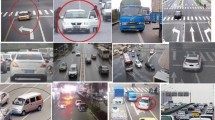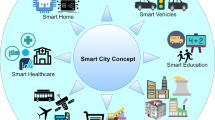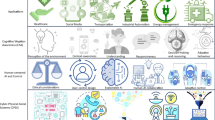Abstract
This study assesses the possibility of using handheld devices to increase commuter safety for adults with cognitive impairments. The system uses a commercial off-the-shelf PDA (Personal Digital Assistant) with built-in GPS (Global Positioning System), enabling individuals to respond to unexpected situations without staff intervention. This study was performed according to an ABAB reversal design, in which A represented the baseline and B represented intervention phases. The data show that participants’ awareness of anomalies significantly increased in target response, thus improving trip safety during intervention phases. Practical and developmental implications of the findings are discussed.




Similar content being viewed by others
References
Brodwin, M. G., Star, T., & Cardoso, E. (2004). Computer assistive technology for people who have disabilities: computer adaptations and modifications. Journal of Rehabilitation, 70, 28–33.
Baus, J., Wasinger, R., Aslan, I., Krüger, A., Maier, A., & Schwartz, A. (2007). Auditory perceptible landmarks in mobile navigation. Proceedings of the 12th international conference on Intelligent user interfaces, 302–304.
Carmien, S., Dawe, M., Fischer, G., Gorman, A., Kintsch, A., & Sullivan, Jr., J. F. (2005). Socio-technical environments supporting people with cognitive disabilities using public transportation. ACM Transactions on Computer-Human Interaction (TOCHI), 12(2), 233–262.
Chang, Y. J. (2010). Anomaly detection for travelling individuals with cognitive impairments. ACM SIGACCESS Accessibility and Computing Newsletter, 97, 25–32.
Chang, Y. J., & Wang, T. Y. (2010a). Comparing picture and video prompting in autonomous indoor wayfinding for individuals with cognitive impairments. Personal and Ubiquitous Computing, 14, 737–747.
Chang, Y. J., & Wang, T. Y. (2010b). Mobile location-based social networking in supported employment for people with cognitive impairments. Cybernetics and Systems, 41, 245–261.
Chang, Y. J., Liu, H. H., & Wang, T. Y. (2009). Mobile social networks as quality of life technology for people with severe mental illness. IEEE Wireless Communications, 16(3), 34–40.
Chang, Y. J., Peng, S. M., Chen, Y. R., Chen, H. C., Wang, T. Y., & Chen, S. F. (2010). Autonomous indoor wayfinding for individuals with cognitive impairments. Journal of NeuroEngineering and Rehabilitation, 7, 1–13.
Cook, A. M., & Hussey, S. M. (2002). Assistive technologies: Principles and practice. St. Louis: Mosby, Inc.
Dutton, G. N. (2003). Cognitive vision, its disorders and differential diagnosis in adults and children: Knowing where and what things are. Eye, 17, 289–304.
Felce, D., & Perry, J. (1995). Quality of life: its definition and measurement. Research in Developmental Disabilities, 16, 51–74.
Ma, T. S. (2009). Real-time anomaly detection for traveling individuals. Proc. of the 11th international ACM SIGACCESS conference on Computers and accessibility, 273–274.
Patterson, J., Liao, L., Gajos, K., Collier, M., Livic, N., Olson, K., et al. (2004). Opportunity Knocks: a system to provide cognitive assistance with transportation services. in Proceedings of The Sixth International Conference on Ubiquitous Computing (UBICOMP), 433–450.
Richards, S. B., Taylor, R. L., Ramasamy, R., & Richards, R. Y. (1999). Single subject research: Applications in educational and clinical settings. New York: Wadsworth.
Shein, G. F., Treviranus, J., Brownlow, N. D., Milner, M., & Parnes, P. (1992). An overview of human-computer interaction techniques for people with physical disabilities. International Journal of Industrial Ergonomics, 9, 171–181.
Siegel, S., & Castellan, N. J. (1988). Nonparametric statistics for the behavioral sciences. New York: McGraw-HiU Book Company.
Sohlberg, M., Fickas, S., Hung, P. F., & Fortier, A. (2007). A comparison of four prompt modes for route finding for community travelers with severe cognitive impairments. Brain Injury, 21(5), 531–538.
Wehmeyer, M., & Schwartz, M. (1998). The relationship between self-determination and quality of life for adults with mental retardation. Education and Training in Mental Retardation and Developmental Disabilities, 33, 3–12.
Wessels, R., Dijcks, B., Soede, M., Gelderblom, G. J., & De Witte, L. (2003). Non-use of provided assistive technology devices, a literature overview. Technology and Disability, 15, 231–238.
Wu, M., Baecker, R., & Richards, B. (2006). Participatory design of an orientation aid for amnesics. Proceedings of CHI, 2006, 511–520.
Author information
Authors and Affiliations
Corresponding author
Rights and permissions
About this article
Cite this article
Chang, YJ., Wang, F.TY., Chen, SF. et al. Anomaly Detection to Increase Commuter Safety for Individuals with Cognitive Impairments. J Dev Phys Disabil 24, 9–17 (2012). https://doi.org/10.1007/s10882-011-9251-3
Published:
Issue Date:
DOI: https://doi.org/10.1007/s10882-011-9251-3




